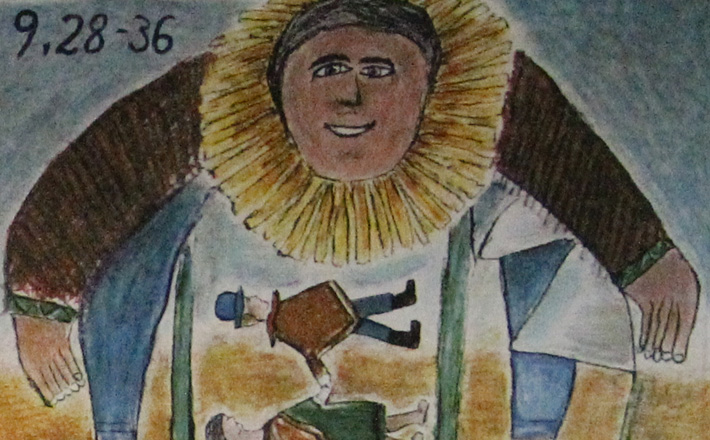Commentary on Exodus 34:29-35
Moses’ countenance glows throughout this scene of covenant renewal, following the sin of the golden calf in Exodus 32.
The Israelites stand in awe of God’s glory reflected in Moses’ incandescent face as he descends from Sinai bearing a new set of tablets inscribed with the “ten words” or commandments of the covenant (Exodus 34:10-28, here a ritual ten commandments, in contrast to the better-known versions in Exodus 20:1-17 and Deuteronomy 5:6-21).
Moses’ shining face embodies God’s steadfast love and faithfulness to Israel, despite the Israelites’ confused and rebellious worship of the image of a calf they proclaim as “the gods who brought you up out of the land of Egypt” (Exodus 32:5). A traditional declaration earlier in Exodus 34 emphasizes that covenant renewal is in keeping with God’s essential character:
“The LORD, the LORD, a God merciful and gracious, slow to anger, and abounding in steadfast love and faithfulness, keeping steadfast love for the thousandth generation, forgiving iniquity and transgression and sin, yet by no means clearing the guilty, but visiting the iniquity of the parents upon the children and the children’s children, to the third and fourth generation” (Exodus 34:6-7).1
The light of divine presence transforms Moses’ appearance on an ongoing basis, whenever he emerges from the tent of meeting after speaking with God “face to face, as one speaks to a friend” (Exodus 33:7-11; cf., Numbers 12:8; Deuteronomy 34:10). Moses’ dazzling face confirms that his plea for God’s presence among the Israelites as they leave Sinai (Exodus 34:9) has been answered, even before the tabernacle is built and filled with glory (Exodus 40:34-38).
On Transfiguration Sunday, we may proclaim with confidence the gracious character of God, who offers a second chance by renewing the covenant and remaining present among the community, as seen first in the face of Moses and then in the face of Christ.
Within the larger narrative context in which the prophet’s absence while mediating the covenant raises doubts concerning his leadership, Moses’ radiant visage affirms his authority as God’s representative. Transformed unconsciously through his mountaintop encounter with God for forty days and nights, Moses brings and even embodies divine revelation concerning the way of life within a covenant relationship with God.
Moses himself is denied a vision of God’s face when he requests to see the divine glory but is granted only a backwards glimpse from a protective cleft (Exodus 33:18-23). By contrast, the Israelites are granted an unexpected and overwhelming vision of Moses’ shining face as it reflects the divine glory.
The curious verb “shone” describing Moses’ skin (Exodus 34:29) is not found elsewhere in the Bible. Since it resembles the Hebrew word for an animal’s “horn,” Jerome in the Vulgate posits that Moses sprouted horns, an interpretive tradition followed by artists such as Michelangelo and Chagall. This image creates an uneasy parallel with the calf fashioned by Aaron in his brother’s absence.
Since elsewhere in the Bible light shines from God’s face as a source of blessing and peace,2 the light shining from Moses’ face creates a more compelling parallel between the deity and his human spokesperson. A close correspondence between the two emerges elsewhere as well, as both God and Moses are portrayed as bringing up Israel out of Egypt (Exodus 20:2; 32:1, 7) and writing upon the stone tablets (Exodus 31:18; 34:1, 27-28).
Today, we might reflect upon how God’s light shines through the actions and lives of leaders and ordinary people of faith, to make God’s transforming presence known in the congregation and wider community.
Given the importance of Moses’ shining visage, the purpose of the “veil” is unclear. The Hebrew word only appears only here, and denotes some sort of mask, hood, or other type of face covering. Since the Israelites responded to Moses’ appearance with fear and reluctance to approach (Exodus 34:29), the veil may have assured and protected them. Even the reflected radiance of God’s presence might be unbearable on a sustained basis, especially to a people suffering from the trauma of sin and its consequences.
Alternatively, the veil may limit Moses’ authority to a mediating role, so that when not speaking to God or to the people on God’s behalf, he conceals his extraordinary appearance as a form of self-effacement. Elsewhere, the Bible notes that Moses was a very humble man (Numbers 12:3).
The periodic veiling of Moses’ face also hints at the Israelites’ fluctuating experience of divine availability and absence. Just as Moses’ face is alternately exposed or cloaked, God’s presence may be at times perceptible or mysteriously hidden. Whatever the case, Paul’s assertion in his metaphorical appropriation that Moses manipulated the veil to deceive the Israelites (2 Cor 3:13) should not be accepted uncritically.
We might develop the imagery of the “veil” to address moments when God’s purpose is unclear, even though we are assured of God’s continued presence in our lives and world.
Fiery imagery for God’s active presence illumines the book of Exodus, as in the burning bush (Exodus 3:3), the LORD’s descent on Mt. Sinai in fire (19:18), and the pillar of cloud and fire accompanying Israel in the wilderness (13:24) and settling on the tabernacle (34:34-38).
The brightness of Moses’ face in Exodus 34:29-35 provides another instance of this passionate imagery and points to the brilliance of God’s own face as the source of blessing and peace, beautifully expressed in the Priestly Blessing: “May the LORD bless you and keep you; the LORD make his face to shine upon you, and be gracious to you; the LORD lift up his countenance upon you, and give you peace” (Numbers 6:24-26).
Consider closing the sermon with the Priestly Blessing to invoke the grace, peace, and blessing of God’s shining face upon the congregation.
1cf., Numbers 14:18; Nehemiah 9:17; Psalm 86:15; 103:8; 145:8; Jeremiah 32:18; Joel 2:13; Jonah 4:2; Nahum 1:3.
2Psalm 4:6; 67:1; 80:3; 119:135; Numbers 6:24-26


February 10, 2013